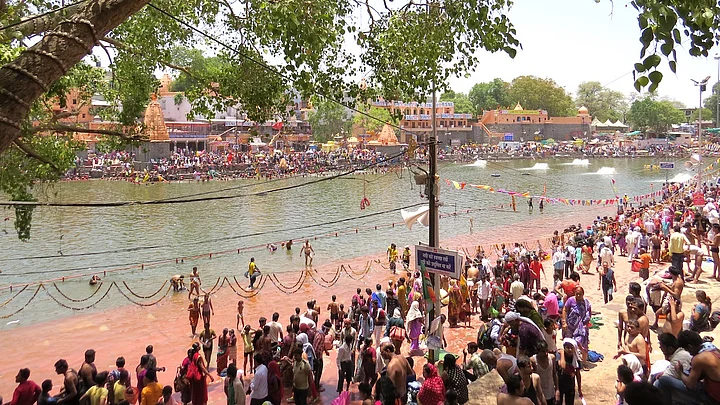When I came to the Kumbh in my childhood, this was a beautiful river flowing with sweet water. Last time (12 years ago), it was a stinking drain, nauseating even to step into, let alone take a dip. The water we see now has been pumped from the Narmada. What have we done to our holy river?Badal Nath, 64, reminisces on the banks of the Shipra river in Ujjain in central India.
Most people did not share the lament of the elderly sadhu from Uttar Kashi. They did not know. Others did not care. The Shipra flowed smoothly through the month-long Simhastha Kumbh Mela held at Ujjain in Madhya Pradesh until the end of May, holding out the hope of salvation to 60 million pilgrims who gathered on its banks to bathe in its waters. But the clear signs of a dying river and interventions that worsen its condition can no longer be wished away.
The situation is starker in the headwaters of the Godavari, where a Kumbh Mela is held as well every 12 years. Ramkund in Nashik, the centre of the great ‘pitcher festival’ last year, dried up in April for the first time in living memory, placing in danger the ancient Hindu ritual of purification in flowing water.
Sinking aquifers and short-sighted public works such as paving banks and even the riverbed in many places has hastened the decline of Godavari, India’s second longest river that starts at a spring on Brahmagiri hill, some 30 km from Nashik in the western state of Maharashtra.
The famous ritual baths during the Kumbh Melas reinforce the fact that it is essentially a water festival, to thank the gods for bountiful water. In a country where over 80 percent of the annual rainfall depends on the moods of the four-month southwest monsoon, water worship is as ancient as the birth of civilisations along rivers.
Clergy or laity, few of the millions jumping in for their ritual baths seem overtly conscious of the lack of flow in the rivers. But the organisers know the risk of massive public anger if the water is missing altogether. Hence the short-term solutions, which are becoming tougher and tougher to sustain.
Hydrological Mess
India is currently facing its worst-ever hydrological crisis, according to river expert Himanshu Thakkar. “Although the change in weather patterns and increasing rise in temperatures have contributed to it, our rivers are facing unprecedented deterioration today because of the way we have ill-treated them,” says Thakkar, co-ordinator of the South Asia Network on Dams, Rivers and People, a non-profit organisation.
A river basin cannot be seen in isolation, says ecologist Somnath Bandyopadhyay, and imbalances caused by human intervention driven solely with the intention of extracting water for irrigation and drinking are bound to lead to consequences that take decades to unravel. “Some of the projects implemented in the 1950s and 60s failed to take the long view, and have contributed to the present sorry situation of sick and dying rivers,” says Bandyopadhyay, associate professor at the School of Ecology and Environment Studies, Nalanda University.
Thakkar is scathing in his remarks on river management. “The ecological ignorance at every level of governance is astonishing,” he says. “How else can we explain pouring concrete over the Godavari riverbed in Nashik and paving its banks, choking off the very aquifers that replenish the river?”
Keeping up Appearances
Instead of taking remedial measures, the authorities seem to be more interested in keeping up appearances, Thakkar says “The entire pipeline project from the Narmada to the Shipra is a result of skewed priorities that just wanted to keep the large number of expected pilgrims happy.”
Bandyopadhyay is sceptical. “The concept of the Kumbh Mela is purifying yourself through water, not rejuvenating or purifying the water. Every pilgrim is concerned about his or her personal salvation. It is doubtful if there will be any concerted action from the Hindus as a community to restore the rivers,” he says. “We seem have learnt very little from the mistakes of the past. Unless there is a change in mind-set and approach, there is little hope that things will change for the better.”
It is not an easy task to get religious institutions and government agencies to pursue a common agenda that results in positive action on rivers, Thakkar says. “We need to work towards raising awareness on the issues. Only then can we start deliberating on solutions.”
For now, it seems that the serious harm to India’s rivers will not be reversed anytime soon. The Ganga will yet flow, perhaps not so freely, in the next Kumbh Mela in Haridwar and then in Allahabad, but time is running out for the Godavari and the Shipra.
(This was first published in indiaclimatedialogue.net. To read a fuller version, click on this link.)
